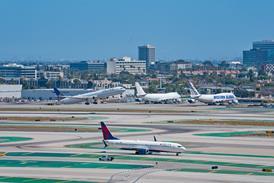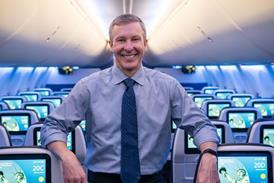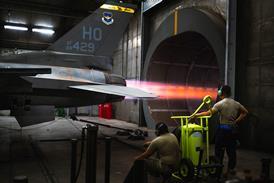Brent Hannon/MANILA
A sharply protectionist aviation policy is helping Philippine Airlines (PAL) on the road to recovery from financial disaster. It is, however, also causing concern among its competitors in the Philippines and overseas. PAL made a 50 million peso profit ($1.17 million) in the fiscal year ending 31 March this year, and has added four aircraft, bringing its fleet to 26. Soon, says PAL president and chief operating officer Avelino Zapanta, the airline will add five more aircraft and launch routes to Australia, South Korea and Canada.
PAL's recovery was made possible by the government's Philippines Securities and Exchange Commission (SEC). It gave PAL protection against its creditors, the European Credit Agencies and the US Exim Bank, which own PAL's aircraft and which have been unable to repossess them.
PAL has also been boosted by a new protectionist aviation policy. In March, the Philippines Civil Aeronautics Board (CAB) indefinitely suspended all scheduled flights to and from Taiwan, abrogating a 1996 air services agreement. PAL had complained that China Airlines and EVA Air were stealing its transpacific customers by carrying them from Manila, through Taipei and on to the US West coast, which PAL said was a sixth freedom violation. This dispute remains unresolved.
South Korea and Singapore are next in line for a renegotiation of air service agreements, said Zapanta. "South Korea would come next because Korean Air is in the same boat, but to a lesser degree than Taiwan," he says. "And Singapore is also operating on the basis of sixth freedom to Europe. It's a very small island with 3 million people. They don't have their own originating traffic."
As with Taiwan, PAL will turn to the CAB for help. Porvenir Porciuncula, head of the CAB's economic, planning and research division, says: "We will review the Singapore situation." Under Philippines President Joseph Estrada, the Philippines has abandoned the liberal air policy of the Fidel Ramos presidency, and protecting PAL has apparently taken priority over the tourism industry. The number of visitors from Taiwan has dropped 60% since the suspension of flights, says Department of Tourism (DoT) Secretary Gemma Cruz-Araneta.
In response, the tourism industry and other businesses have formed the Freedom to Fly coalition, which is trying to enforce an executive order by former President Ramos in 1995, which opened the country to airline competition. "The official policy is progressive liberalisation - that's the law," says Cruz-Araneta.
Because PAL's wounds are self-inflicted, the coalition believes the airline should not have government protection. Since PAL owner Lucio Tan took over the airline in 1995, it has lost nearly $500 million, and is now $2.2 billion in debt. In July 1998, PAL went bankrupt and was given SEC protection. It suspended all flights for two weeks in September 1998 and all international flights for two months after that. The fleet was cut from 56 to 22 aircraft, a reduction which sharply reducing the country's international connections.
Because of PAL's struggles, the number of airline seats into the Philippines has fallen 66% in two years, from 7.8 million in 1997 to 4.7 million in 1999, according to the CAB.
In March, the Freedom to Fly coalition filed a bill in Congress that would force the administration to obey the progressive liberalisation policy. It may be an uphill battle. The CAB has sided with PAL in the dispute with Taiwan, although it admits that the Taiwanese carriers did not violate the 1996 agreement. "Sixth freedom is not included in the agreement, but if it is not expressly granted, you cannot do it," says Porciuncula.
Tan supported Estrada's election campaign, and some believe Estrada is returning the favour by helping PAL. Says secretary Cruz-Araneta: "That's the way politics is done in this country." Neither does Zapanta wish to return to progressive liberalisation. "Our previous administration has given away too many seats," he says. "The Ramos administration wanted economic improvement. And one of the things they did was to open up the Philippines, but in their case they just gave it away."
While Singapore Airlines (SIA), Korean Air, Asiana and others might eventually be affected, the first casualty of the new protectionism may be Cebu Pacific Air, a domestic carrier with international ambitions. "Cebu Pacific has filed three times to fly scheduled international routes, but they have not been given final authority," says Abad. Cebu Pacific is finalising an order for 14 Boeing 717s, which it wants to fly to Singapore and Jakarta after delivery next year. Two airlines are authorised to fly to Singapore under the existing agreement, but it is up to the Philippines Government to approve the second carrier.
How does it feel to compete in a country dominated by PAL's political connections? "It makes things interesting at times, but there's nothing that you can't overcome," says Ron Ridgeway, Cebu Pacific Air managing adviser.
The DoT, meanwhile, has found a creative way to maintain tourist traffic from Europe. PAL dropped its European routes two years ago, so last September the DoT signed an agreement with SIA under which it and the DoT jointly promote the Philippines to the European market. SIA gains access to the 260,000 Europeans who visit the Philippines every year, and the Philippines maintains a steady flow of visitors from the Continent. The agreement has enraged PAL, which hopes to re-launch flights to Frankfurt next year. It will have difficulty luring European customers away from SIA, one of the world's top carriers.
"They [PAL] should thank us. We maintained their market presence in Europe at no extra expense, " says the DoT's Cruz-Araneta.
Lease payments
Although PAL appears to have turned the corner, enormous problems still remain. The airline owes $2.2 billion and in fiscal year 2000 it made only one debt payment, in March, and made its first aircraft lease payments in April. "PAL enjoyed a soft year, when they didn't make any of those payments," says Ridgeway. "They're trying to service a $2.2 billion debt with just 26 aircraft. That's a big number." PAL's $1.22 million profit for FY2000 is small, but encouraging. The airline projects a profit of $64 million for the current fiscal year, boosted by revenue from the new routes and aircraft, and by the sale of its maintenance operations to Lufthansa Technik. That move will reduce PAL's payroll by about 1,500 employees.
By August, the airline will add two more Airbus A340s, suitable for long-haul operations, and it plans to acquire three more Boeing 747s, bringing its fleet to 31 by early 2001. By putting those aircraft on to routes to Sydney, Pusan, and Vancouver, PAL hopes to make enough money to acquire more aircraft and re-launch flights to Europe, starting with Germany, and increase flights to the USA. PAL may use Vancouver as a hub to serve North America. Vancouver's low airport charges and shorter flight time from Manila make it an attractive choice. From Vancouver, or its former hub in Los Angeles, PAL plans eventually to add flights to the USA. But the carrier is proceeding cautiously. "As far as expansion is concerned, we are being very careful," says Zapanta. "We have to ensure profitability, otherwise the creditors won't agree. We are still under receivership."
The labour problem remains unresolved. Unrest triggered PAL's bankruptcy, when the PAL pilots' union staged a three-week strike in June 1998. "As far as the union is concerned, we are in a very precarious situation," says Zapanta. Tan has tried to sell PAL for $800 million, without success. Meanwhile, Asia's oldest airline is making the most of its opportunities. "There will not be another chance for PAL," says Zapanta.
Source: Flight International























